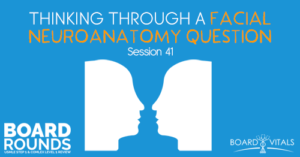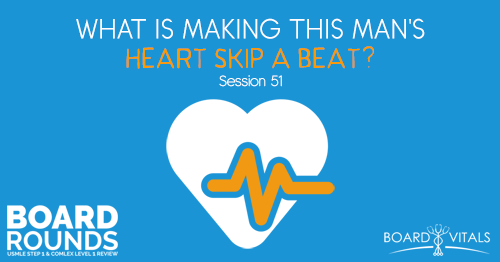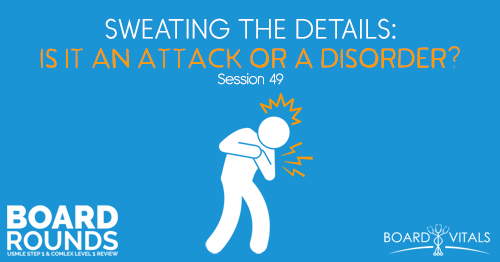Apple Podcasts | Google Podcasts

Session 41
A 62-year-old female presents with impared taste and drooping on the right side of her face, but her hearing is normal. Where is the probable lesion located?
It’s a privilege to be joined once again by Dr. Mike Natter from BoardVitals as we dissect another questions as follows:
A 62 year old female presents with drooping on the right side of the face and impaired taste stating that “I can’t taste my food.” Normally, her hearing is normal. Where is the probable lesion located?
(A) In the mastoid segment of the facial nerve proximal to the chorda tympani and distal to the nerve to the stapedius
(B) At the cerebellopontine angle
(C) In the tympanic segment distal to the geniculate ganglion but proximal to the stapedius nerve
(D) Distal to the styloid foramen
(E) Distal to the greater petrosal nerve branch and proximal to the mastoid segment.
Listen to this podcast episode with the player above, or keep reading for the highlights and takeaway points.
[02:47] Thought Process Behind the Correct Answer
There’s drooping of the face so we’re dealing with the facial nerve. And there’s impaired taste, which is also part of the facial nerve. The lesion is obviously distal to where that hearing gets broken off.
It looks like we have a bit of a palsy so we could talk about the facial nerve and recalling where the facial nerve kind of exits or branches out into a bunch of different things.
But the coolest thing about the facial nerve is this branch called the chorda tympani that is responsible for the anterior two-thirds of your tongue.
For the taste part, we’re thinking facial nerve so it’s something with the chorda tympani. But then if sound is intact, the hearing is intact, then we’re sparing whatever segment that is.
There are three tiny bones in the inner ear. One of them is the stapedius and if the nerve to the stapedius is not affected, then we can say that might hold on to our sound.
The cerebellopontine angle would only be hearing. So B is out.
The foramen is where things are coming out of styloid. Hence, the styloid foramen would not be involved in this because that would knock out more so we can get rid of D.
The tympanic segment on its own is going to be sound. And so if that’s knocked out then that’s going to be affected. So C should be out.
Now, we’re left with answer choices A and E.
The mastoid segment of the facial nerve would cause her droop. If we’re proximal to the chorda tympani then the chorda tympani should be affected because it’s proximal. But then if we’re distal to the stapedius then the stapedius should be spared and that makes some sense.
Therefore, A is the correct answer.
The facial nerve has special sensory afferent fibers, which serve the anterior two-thirds of the tongue. Then there’s the localization of the branches of the facial nerve. And what we can also use to determine the site of where that lesion is being proximal or distal, which will spare or include other areas.
[06:44] Studying Techniques
It’s a little unfortunate because it comes down to at least rote memorizing some things. But then once you rote memorized a few things, you can then use those to intuit other things.
“Unfortunately with questions such as these that are very kind of granular and specific and not particularly clinically relevant, you're going to be stuck with memorizing a lot.”Click To Tweet[07:53] How This is Applied to Residency
“You do not have to be a library of information. You have to be a librarian. You have to know what you don't know and know where to look it up.”Click To TweetNo good doctor is a repository of facts. A good doctor is someone that can communicate and also admit when they don’t know things. It’s not expected of you either as a medical student, as a resident or even as an attending to know all the answers.
And we have these devices. We have our phones or iPads or computers literally at every turn and every corner. It would be almost irresponsible of us to not utilize that technology to then double check ourselves, look stuff up, and kind of come to the correct answer.
Moreover, medical school unfortunately does make you have to learn and memorize a lot of things. More importantly, it’s learning how to think and learning how to interact. It’s kind of like coming out of that four years.
You have a lot of rote material at your fingertips, but you’re also going to forget a lot of that. A lot of it’s not gonna be relevant to you.
It’s true that we learn things at such a granular level so that we can understand from the most basic to the most complex. But it doesn’t really matter clinically to the same level that we’ve learned it. And that’s, that’s something you have to keep that in mind as well.
[09:25] Is Not Knowing Everything a Weakness?
Some people think that needing to go to a computer to look for something is a sign of weakness and that we’re not skilled or not smart.
Mike says he enjoys when a patient asks him something and he tells them he’s not sure, but he encourages them that they figure it out together or he’d tell them that he’d look it up and get back to them. That way, it reinforces that concept that we are not all knowing.
“We’re not omnipotent. We’re human beings. We’re physicians and we’re smart and we know a lot of things. But
“Just because we don't know every single answer, every single question when it's given to us, doesn't make us a bad doctor.”Click To TweetThere’s actually data on this that patients really respect when a doctor is honest and forthcoming when they aren’t sure about something.
Mike came from a background of no medicine. And he went into medical school thinking things were black and white and that their diagnosis is correct all the time. But he learned that medicie is the opposite of that. It’s shades of gray and no disease process reads the textbook exactly.
And so you’re going to get patients that present weirdly, that may have one very strange presentation of a disease, or they may have three different diseases and it’s presenting very strangely.
Even if they have a really very run-of-the-mill bread and butter disease, the treatment for them, because they’re an individual may be different from what the textbook tells you.
And so it’s just kind of understanding that and working with your patient and making it more of a partnership.
Links:
BoardVitals (Use the promo code BOARDROUNDS to save 15% off)
Follow us on Instagram @medicalschoolhq and @mike.natter.
SEARCH SITE
LISTEN FOR FREE











